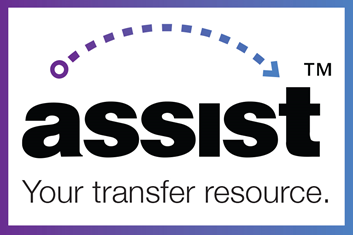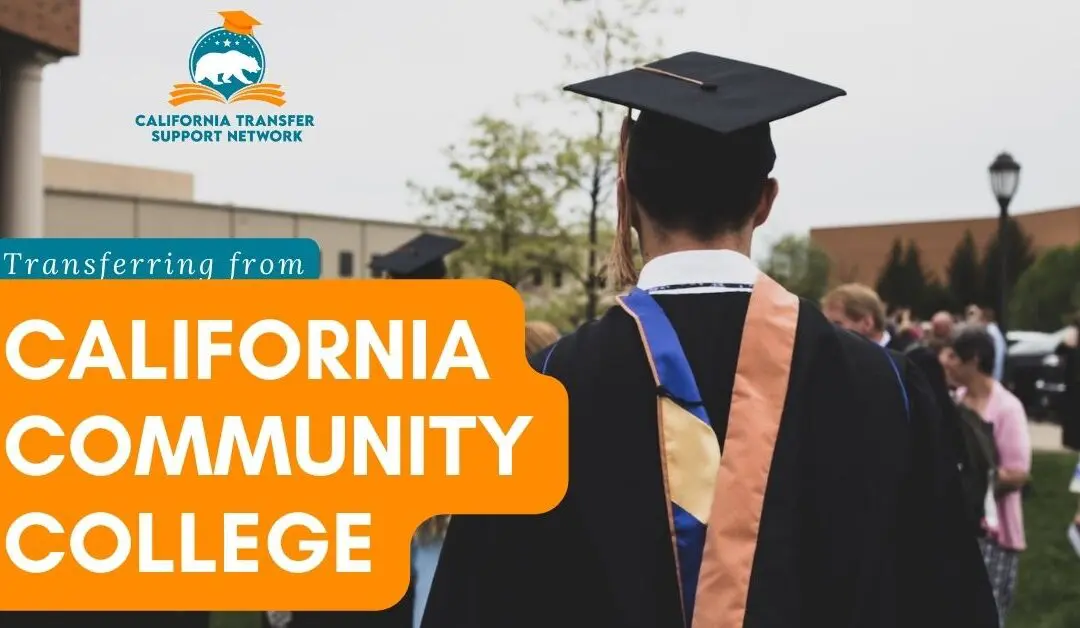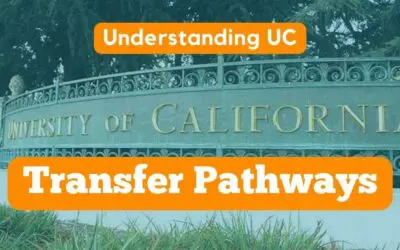Community college students in California can transfer to a four-year school if they know what they want and do their research. Some students have to start over at a four-year college because they didn’t plan properly. So whether you’re just starting at community college or getting ready to transfer, read on! In this post, I’ll discuss the different transfer types and how to ensure your successful application.
Requirements for Transferring to a CSU or UC from Community College
Approximately 80,000 California community college students move directly to a University of California or California State University campus every year.
Over 38,000 California community college students earn an Associate Degree for Transfer annually, guaranteeing entry as juniors to a Cal State campus and other participating institutions.
Enroll in a California Community College
The first and most obvious step in the transfer process is to enroll at a California community college and begin taking classes.
Once you enroll, submit any dual enrollment course credit or AP exam scores to the registrar’s office so they can evaluate the credit you have coming in.
To dramatically improve your chances of transferring in two years, we suggest preparing to take classes year-round and enroll in courses throughout Summer, Fall, Intercession, and Spring.
Complete General Education and Major Preparation Coursework
A critical but often botched part of the transfer process is completing general education requirements and, more importantly, major preparation coursework.
Transfer students declaring an impacted major will have to navigate specific major and GE requirements depending on the campus they are interested in. To qualify for admission, one must graduate from high school and be admitted to a California community college campus.

It is not enough to simply complete general education courses and expect to transfer to a UC or CSU in a competitive major. Most UC campuses require students to complete general education courses and the required major preparation classes before they can transfer.
Depending on your degree program and transfer pathways, specific campuses require major preparation coursework to be completed, while other majors have the courses as recommended.
Regardless, you must utilize resources like ASSIST to locate the appropriate articulation agreements between your community college and the UC or CSU system school you are interested in transferring to.
What GPA do you Need to Transfer from a Community College to a UC or CSU?
The GPA necessary for admission can vary from year to year and depends on the campus, the major, and the applicant pool.
The CSU accepts a 2.0 (2.4 for California non-residents) GPA as the minimum for admission to the university.
The minimum grade point average required for UC admittance is 2.4 (2.8 for non-residents). Check with the school you are interested in transferring to see their specific requirements.
Is it Hard to Transfer from CC to UC or CSU?
It can be challenging to navigate the transfer process between CA community colleges and the UC and CSU system.
Understanding Articulation Agreements
The higher education landscape in California can be complex, but the three prominent institutions of higher learning (CCC, UC, and CSU) have partnerships to ensure successful four-year degree completion.
Students transferring from a CCC should consult the articulation agreements provided by their institution.
One reason it is hard is that students are unfamiliar with the complexity of articulation agreements and transferable course lists.
Community college counselors are generally swamped at the beginning of the year, and some students have to enroll in classes themselves, ultimately leaving them susceptible to taking non-transferable courses.

For example, if you are a majoring in ethnic studies and want to transfer to UCLA, navigate to ASSIST and fill in the required fields in the drop-down menu to identify relevant general education requirements and ensure success in transferring from
Related: Transfer College Using ASSIST Org | California Transfer Support
Pressure to Succeed
Another reason is the pressure to succeed in a community college setting and meet GPA, credit, and other requirements for transfer. Community college students must combat outside events like work and children, which can impede academic success.
Stay Focused on Transferring
Some successfully transferred students share their stories and successful strategies so that others may follow in their footsteps. Developing a relationship with a counselor or joining a study group can make all the difference.
Staying focused on your educational goals is also critical. Despite the challenges, many students succeed in transferring to the University of California or the California State University system because they are constantly communicating with counselors and academic advisors about the institution they want to transfer to.
Completing a bachelor’s degree rewards great; increased earnings potential, job satisfaction, and improved health outcomes are just a few of the benefits of obtaining a four-year degree.
Therefore, it is essential to remain engaged and focused on your education path despite any challenges you may encounter.
What Percentage of California Community College Students Transfer?
According to the most recent accountability report released by California’s community college system, only 40 percent of community college students who seek four-year degrees successfully transfer to one of the state’s four-year universities.
Each community college district’s governing board shall make the transfer process a fundamental purpose.

It must place a premium on the training and transfer of underrepresented students, particularly African- American, Chicano/Latino, American Indian, disabled, and low-income individuals who are historically or currently underrepresented in the transfer process.
California Community College Degree Programs
Associates Degree
Many students choose to obtain an associate degree at a junior college. An associate degree is a two-year program that can serve as valuable credentials by themselves or lay the groundwork for furthering one’s education with a bachelor’s degree.
Furthermore, an Associate Degree often provides students will the skill sets and abilities sought after in many industries and sectors.
For example, many students use their associate’s degree as a stepping stone to a bachelor’s degree, while others use it to start their career in a particular field.
No matter your goals, an associate’s degree can be a great way to begin your educational journey.
Related: Associate Degrees: Credits Needed & Time to Completion
Bachelor’s Degree
Believe it or not, a handful of California community colleges have the power to grant bachelor’s degrees in specific majors and subject disciplines.
After Assembly Bill 927, a pilot program was established, allowing 15 community colleges to develop a baccalaureate program.
Restrictions on the types of bachelor’s degree programs and subject matter are laid out in the bill.
Still, advocates praise the work in the California State legislature for their commitment to improving the flexibility and the authority of California community college programs.
Please note that most CCC does not offer a bachelor’s degree program; if they did, it might not be in the field or major choice you are interested in.
Consult with your local community college counselor to assess whether a bachelor’s degree is available at your local community college.
Associate Degree for Transfer
Do you need more help acquiring a new degree or a better job? The primary difference between a traditional associate degree and an associate degree for transfer is that an ADT provides guaranteed admission to any of the participating colleges and universities.
Completing major education requirements at a community college in California guarantees a guaranteed place at participating 4-year universities.
What is the California Community Colleges-Associate Degree for Transfer Program (CCC-ADT)?
The Associate in Art for Transfer (AA-T) and the Associate in Science for Transfer (AS-T) degrees are two-year associate degrees fully transferable to the CSU. They have no more than 60 semester units or 90 quarter units.
The CSU offers several Associate Degrees for Transfer (ADT) — sometimes known as a Degree with a Guarantee. Students who fulfill the CSU’s minimal requirements are assured priority admission to a CSU campus, even if they do not choose a specific campus or major.
The great thing about an ADT is that if you study a similar program to the one you did at California Community College at a CSU, you will only need 120 units to earn both your associate’s and bachelor’s degrees.
Consider enrolling in CSU’s Associate Degree for Transfer Program (ADT) if you’re already a California Community College student or are considering applying.
The primary difference between a traditional associate degree and an associate degree for transfer is that an ADT provides guaranteed admission to any of the participating colleges and universities.

Visit the college’s transfer center or speak with a counselor to learn more about available AA-T and AS-T degrees and devise a strategy for transferring to the CSU as part of the ADT program.
Unsure if your intended transfer institution supports the Degree with a Guarantee program?
Check out this resource to identify the participating California Independent Non-Profit universities, Historically Black Colleges and Universities (HBCUs), and Fully Online and Out of State Universities.
What Courses do I Need to Transfer from a Community College?
To answer this question more accurately, I would have to know the community college you are attending, the major you declare, the UC or CSU you are interested in transferring to, and whether or not you have any applicable college credit or AP credit from high school.
Related: Cuyamaca College: Everything you Need to Know!
Nonetheless, there are some transfer resources that can dictate the direction you must go to ensure your enrolled courses will transfer.
ASSIST-org
As a student, knowing what courses will transfer to the CSU and UC systems is essential because it can save you time and money.
While each university has its process for determining which courses will transfer, ASSIST is the official repository that houses all articulation agreements for California community colleges.
If you want to transfer to a specific school, you can use ASSIST to see which of your community college courses will count towards your degree.
Recommended Reading: Determine How Your College Credits will Transfer | Course Articulation
In some cases, students may need to take additional courses to meet the requirements of their desired major, but in most cases, all of the credits from your community college will transfer over.
Even though ASSIST is a great resource, it is always best to check with an academic advisor at your community college and your desired transfer school to get the most accurate and up-to-date information.
UC Transfer Admission Planner
As a transfer student, you may wonder what courses will transfer to CSU or UC. The UC Transfer Admission Planner is an excellent transfer tool that can help you determine which classes will transfer and meet admission requirements for transfer.
The planner is free and easy to use and will give you an idea of which classes to take to transfer to your desired school. In addition, the planner can help you keep track of your progress and ensure that you are on track to transfer.
If you are looking to transfer to CSU or UC, the UC Transfer Admission Planner is a valuable tool to help you plan your transfer path.
Related: Find Out When UC Decisions Come Out?
Conclusion
Community colleges offer a variety of degree programs and courses that can help you prepare for a successful transfer to a CSU or UC.
With the right planning and preparation, attending one of California’s prestigious universities is possible without spending four years in undergraduate studies.
Financial aid opportunities are available to those who qualify, and many community colleges have on-campus graduation ceremonies.
Contact us for free support if you want to attend a California community college and eventually transfer to a UC or CSU school. Our team is here to help make your dreams a reality.
California Transfer Support Network is a federally recognized 501(c)(3) organization and operates solely on donations from our generous donors. Our mission is to support California community college transfer students throughout the transfer process by providing free and accessible student support services.





